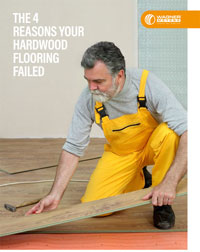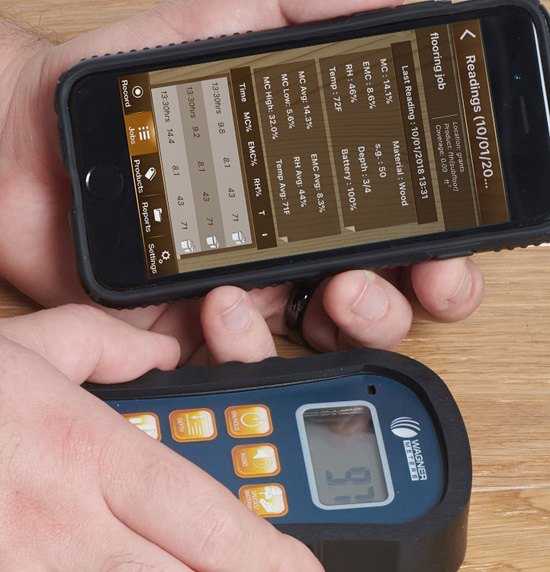Keep Your Natural Wood Floor Pristine by Managing Its Moisture Content
Previously published by Tomorrow’s Contract Floors magazine.
It’s finally happening.
Even though man-made vinyl, linoleum, rubber, and laminate continue to be popular floor coverings for homes and businesses, there are still plenty of people in both the US and Europe who swear by natural flooring. In fact, these people — who are often motivated by concerns about the environment — are outright shunning anything perceived as overly manufactured or artificial and this includes synthetic flooring.
The Benefits of Natural Flooring
 Natural flooring is often better for the environment. It’s also incomparably beautiful, durable, resilient, and healthier for living spaces. It’s warmth and classic elegance can serve to create some truly breathtaking first impressions.
Natural flooring is often better for the environment. It’s also incomparably beautiful, durable, resilient, and healthier for living spaces. It’s warmth and classic elegance can serve to create some truly breathtaking first impressions.
It’s also easy to maintain and clean. Just sweep or vacuum and you’re done. Sure, it’s more expensive than synthetic flooring. However, with proper care, natural flooring will last for decades.
Natural flooring can also increase the value of your property. Nobody wants someone else’s used carpets full of nasty allergens like dust mites, pet dander, pollen and who knows what else. If your home has natural flooring, it may sell faster and for more money.
So, let’s talk about natural flooring and moisture…
Some Natural Flooring Material Is Hygroscopic
Some natural flooring material — including wood, cork, and bamboo — is hygroscopic. This means they act something like a sponge. They’re able to both absorb moisture from the environment and release moisture back into the environment. It works like this.
When these natural flooring materials have less moisture than the surrounding environment, they will absorb moisture from the environment. When they have more moisture than the environment, they will release moisture back into the environment. When this happens, the natural flooring material will either physically expand or shrink in size. When it absorbs moisture, it expands, and when it releases moisture, it shrinks. And when your natural flooring physically shrinks or expands too much, you could end up with problems. Big problems.
So, let’s take a quick look at these hygroscopic natural flooring materials and their relationship with moisture.
Types of Natural Flooring
Bamboo
People think of bamboo as wood. However, it’s actually a grass. It’s also an environmentally-friendly renewable resource because it quickly grows to maturity in just 3-5 years. Durable and easy to maintain with an appearance similar to hardwood, it lends a touch of elegance to any space.
Bamboo’s Relationship with Moisture
While bamboo is more resistant to moisture than your average hardwood, too much moisture can cause problems like warping and mold growth. If it’s installed in a humid environment, the moisture in the air will cause the individual pieces to swell and if it’s placed in a dry environment the pieces will shrink. If this happens, the bamboo could crack, deform, or show gaps in between the pieces.
Hardwood
Hardwood floors are available everywhere and are created using thick pieces of solid timber installed over a layer or two of plywood.
Hardwood’s Relationship with Moisture
Wood’s hygroscopic nature means that hardwood floors probably shouldn’t be used in moisture-prone areas such as basements and bathrooms. However, some finishes can increase the wood’s ability to resist moisture.

Free Download – 4 Reasons Your Hardwood Flooring Failed
Cork
Cork flooring is created by grinding up the cork found on the Quercus suber or cork oak tree, compressing it, and then forming biodegradable resin-bound sheets.
Cork is trendy right now because it’s a renewable resource in that we’re able to harvest it without harming the tree. The cork then grows back and can be harvested again.
Cork is hypoallergenic and can be cleaned by simply sweeping or vacuuming.
Cork’s Relationship with Moisture
Cork has a finish over it that will protect it from moisture. However, that doesn’t mean it can’t get damaged by moisture. High humidity levels will cause the cork to swell and curl. In some cases, the individual cork tiles might even pop out.
Engineered Wood
While hardwood flooring is a thick layer of solid wood pieces, engineered wood is a thin top layer of hardwood that has been bonded to layers of high-quality plywood. This is done to prevent the floor from physically shifting as humidity levels fluctuate.
Engineered Wood’s Relationship with Moisture
Because of the way engineered wood is manufactured, it’s more resistant to movement than solid hardwood and won’t warp as easily when it comes into contact with moisture, but it’s by no means immune.
Moisture and Natural Flooring
While moisture is important for synthetic flooring, managing moisture is very important when it comes to natural flooring because of the hygroscopic properties we mentioned above. If the moisture in natural flooring isn’t properly managed it can lead to unsightly buckling, crowning, and cupping.
Moisture Meters: A Useful Tool for Managing the Moisture Content of Natural Flooring
 Moisture meters are small, hand-held devices that measure the moisture content of wood and other materials. They’re used by both professionals and hobbyists because prior to installation too much or too little moisture in natural materials like wood, cork, and bamboo can cause serious problems. In fact, even after installation, your natural flooring may still be subject to the negative effects of fluctuating ambient conditions, so you’ll want to address that too.
Moisture meters are small, hand-held devices that measure the moisture content of wood and other materials. They’re used by both professionals and hobbyists because prior to installation too much or too little moisture in natural materials like wood, cork, and bamboo can cause serious problems. In fact, even after installation, your natural flooring may still be subject to the negative effects of fluctuating ambient conditions, so you’ll want to address that too.
This is why it makes sense for owners of natural flooring to use a pinless wood moisture meter like the Wagner Orion 950 to manage their floor’s moisture content. It not only measures the moisture content in wood but the ambient temperature and relative humidity as well. It even calculates the Equilibrium Moisture Content (EMC) of wood, allowing you to know what moisture content the wood will eventually equilibrate to in that environment, and even has Bluetooth connectivity to a free smart device app for data recording and easy, comprehensive reporting.
Another useful tool is Wagner’s Smart Logger. It will allow you to monitor ambient conditions for temperature and relative humidity spikes and is capable of logging 12,000 readings over 300 days of replaceable battery life. This allows a flooring installer to have a conversation with the homeowner about the proper care and monitoring of their “living, breathing” floor so that it will last a long time — a win for both the installer and the owner.
Natural floors are a beautiful addition to any home or building space and will last for years with proper care. This includes carefully monitoring the moisture content of the natural flooring materials both during and after installation since a cost-effective and environmentally-friendly flooring choice becomes the exact opposite if you need to tear it up and replace it.
Jason has 20+ years’ experience in sales and sales management in a spectrum of industries and has successfully launched a variety of products to the market, including the original Rapid RH® concrete moisture tests. He currently works with Wagner Meters as our Rapid RH® product sales manager.
Last updated on May 4th, 2021

